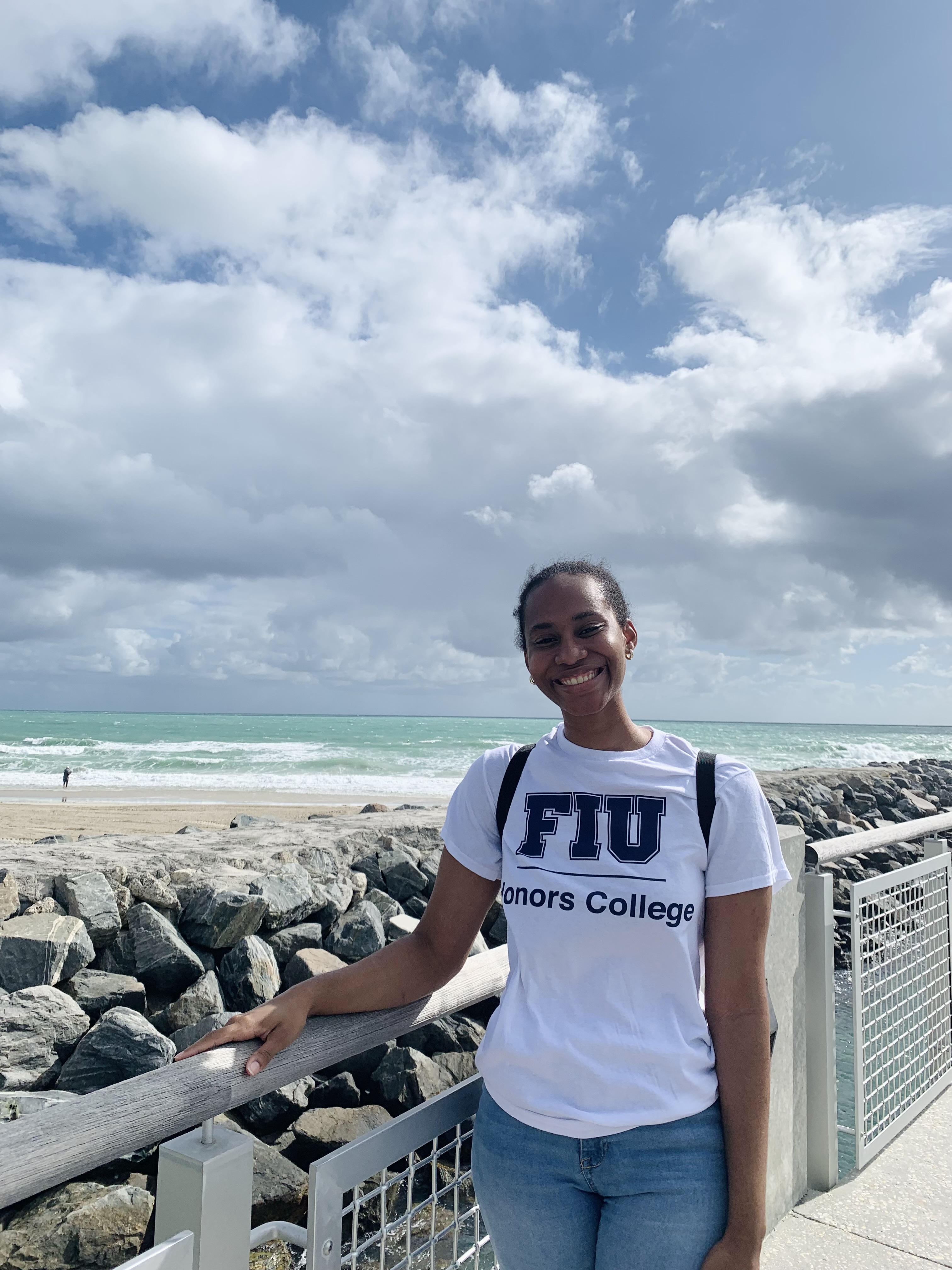
Photograph of Yana Judah taken by Lillie P. (Miami, Florida 2023) // CC by 4.0
Yana Judah is a junior at Florida International University (FIU) pursuing a Bachelor’s degree in Computer Science and a Certificate in Chinese Studies. A proud Miami native with Caribbean roots, she grew up with faith, strong family ties, and a deep love for the performing arts. While she enthusiastically studies to earn her degree and certificate, she continues to involve herself in the music space by playing guitar with her family band, engaging in jazz vocal instruction, and releasing original projects. Her two-year dedication to marching trombone with FIU’s very own Wertheim Marching Band is a source of accomplishment and joy.
Art Encounter as Text
“Jared Small” by Yana Judah of FIU on January 18th, 2024
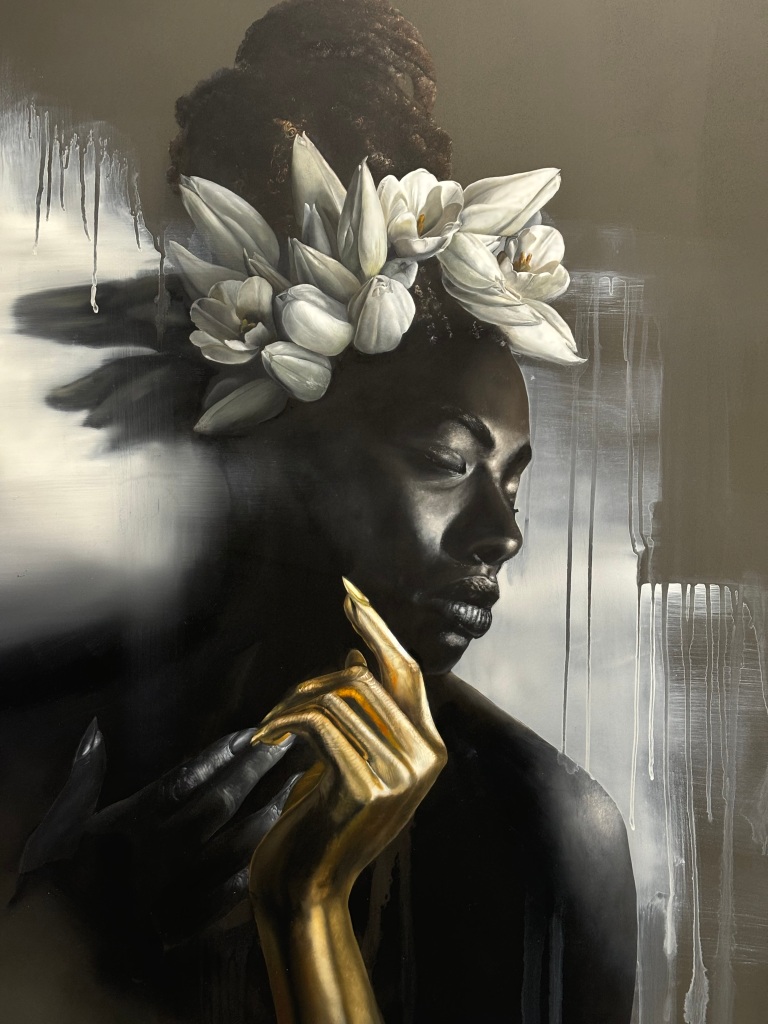
Jared Small’s Black Gold at SCOPE 2023 (Photo by Yana Judah // CC by 4.0)
On December 6th, 2023, Professor Bailly’s Miami in Miami class ventured into unfamiliar territory: Miami Art Week. This was a far cry from our usual physically demanding (at least to someone like myself) excursions of long walks, hiking, or canoeing. Throughout these course meetings, we definitely examined both hedonistic and religious artworks, stylistic buildings, and architectural themes. However, the focus of intensity on pure art was unquestionably exhibited at Miami Art Week. This is what I consider to be my first formal introduction to the art world, and this is also where I laid eyes on Black Gold (image included above) at SCOPE.
Your eyes instantly soak in the gold leaf left hand clasping the black right hand; you see the white flowery headpiece with hints of orange circling the woman’s braided bun. You wonder about their meaning and admire their elegance. Yet, as breathtaking as this piece is (it’s currently my phone’s wallpaper), up until five minutes ago, I did not know who formed this stunning piece.
Jared Small is his name (“Jared Small”). And frankly, I am slightly embarrassed not to have sought it out sooner. After all, producing such a piece requires both creativity and the mastery to execute it. I am still determining why I did not have the conviction to recall the artist’s name, especially when the artwork seized my attention. Perhaps it was an honest case of not being thorough. Or, daringly enough, might I say, I did not show enough respect or consideration for the artist. This, in particular, hits a delicate spot for me, as I am a lover of music both as a listener and performer. When there is a song I am in tune with, I always attempt to find the musician’s name. Why didn’t I pay the same dues to Jared Small?
As this new semester begins with Professor Bailly’s Art in Miami course, I aim to expand my familiarity with the art space: I want to recognize pieces and debate their meaning; I want to recall the respective artist’s name with confidence. Moreover, I want to explore Miami’s art scene with renewed eyes. Last semester, we unearthed the multilayers of Miami’s history, internal battles, and beauty. Hopefully, I, and every student in Art in Miami, can reflect on truths previously uncovered and detect similar themes in the artwork. Hopefully, we can connect the dots between Miami’s history and the level of persuasion it plays on both native and non-native artists.
Wildly enough, despite being a native Miamian, my understanding of art as it pertains to my city is limited. Now, sure, I am accustomed to Miami art and its artist being praised for their extreme originality and multicultural backgrounds. However, if called for, I do not have much information to enlighten a conversation – well, outside of generalities (that even a non-Miami native could pick up on).
Nevertheless, I am certainly thrilled to begin this pathway of learning something new, especially since it pertains to my home. I’ll start by remembering Jared Small’s name.
Works Cited
“Jared Small.” David Lusk Gallery, dlg-craft.frb.io/artists/jared.small.
Norton as Text
“Go Away, Find Yourself” by Yana Judah of FIU at Norton Museum of Art on January 19th, 2024
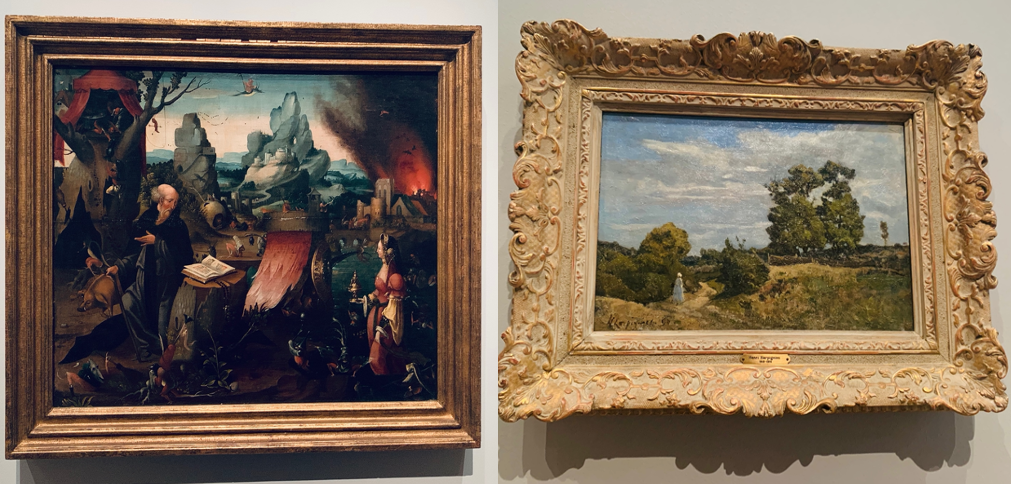
Right: Jan Wellens De Cock’s Temptation of Saint Anthony | Left: Henri-Joseph Harpignies’ Landscape with a Woman On a Road | Norton Museum of Art 2024 (Yana Judah// CC by 4.0)
Within FIU’s community, there is an abundance of students who experience blessings and privileges daily, myself included. Leading enriched lives—ones with weekend family dinners with grandma, laughable post-class volleyball matches, and intense pizza-game nights with dormmates. We have access to food, water, shelter, and a proper shot at a quality academic pursuit. But that does not mean we are void of suffering.
Crippling anxiety, social anxiety, friends, fake friends, insincere intentions, counterfeit personalities, kindness abused and misused, heartbreak and heartache, inquiries of graduation dates, conversations of family legacy, job security, thirteen-an-hour wages, dialogs about student loans, failing a pre-requisite class, stress hinders your sleep, but you need to sleep, you can’t miss class, temptations to drop, bracing for the future, facing your past, and you feel the weight of every choice or lack thereof on your shoulders.
Through this feeling of weighted suffering, through this turbulent, individual journey we all go through, we must keep focus on the big picture. Whether it is graduating on time or, hey, even graduating period, to prevail, we must eliminate dangerous distractions and focus: protect our dreams, protect our peace, and protect our goals. We must stay on the path amidst the hell close to us.
This reality, which I give from the perspective of college students, is the first thought that dashed through my mind when our Art in Miami class visited the Norton Museum of Art and laid eyes on the Temptation of Saint Anthony.
Titled Temptation of Saint Anthony and painted by Jan Wellens De Cock, it is the leftmost painting pictured above this blog post. It depicts the legend of Saint Anthony, a recluse “living alone in the desert, where he was repeatedly tempted and taunted by devils” (Norton Museum of Art). The legend is portrayed clearly in De Cock’s painting. Saint Anthony is shown concentrating on an open Bible while chaos ensues around him. There is a multitude of temptations and distractions. Moreover, the collapse of a society is revealed through fiery explosions. Yet, Saint Anthony remains steadfast, focused on the Bible, which is his task – much like how our task in college is to stay aligned with our goals.
Staying faithful to your purpose may prove challenging, as Saint Anthony is encircled with evils, but that is just a reminder of why seeking peace of mind is critical and crucial. The notion of finding solace and longing for it is a concept I witnessed in another painting at the Norton Museum of Art, Landscape with a Woman On a Road, by Henri-Joseph Harpignies. It is the rightmost painting pictured above this blog post.
The title is justified through the depiction; a woman in the distance walks a trail, but not in haste. She moves at her own pace up a landscape of greenery. She is alone, but she does not appear lonely. The woman is at peace or perhaps on the way to find it. As she moves, I feel the nature immediate to her replenish her spirit. To gain stability, she needed to go away.
And perhaps that is the most powerful takeaway from both Landscape with a Woman On a Road and Temptation of Saint Anthony. The world is chaotic, with often hurtful amounts of pain, high pressure, and arm-twisting uncertainties. We have our goals and have no choice but to fight for them, lest we quit. If we are overwhelmed, with our peace at risk, perhaps the antidote is to go away and find yourself.
Works Cited
De Cock, Jan Wellens. “Temptation of Saint Anthony.” circa 1520-1525, Norton Museum of Art, West Palm Beach.
Margulies/Bakehouse as Text
“Articulation” by Yana Judah of FIU at Margulies Collection at the Warehouse on February 2nd, 2024
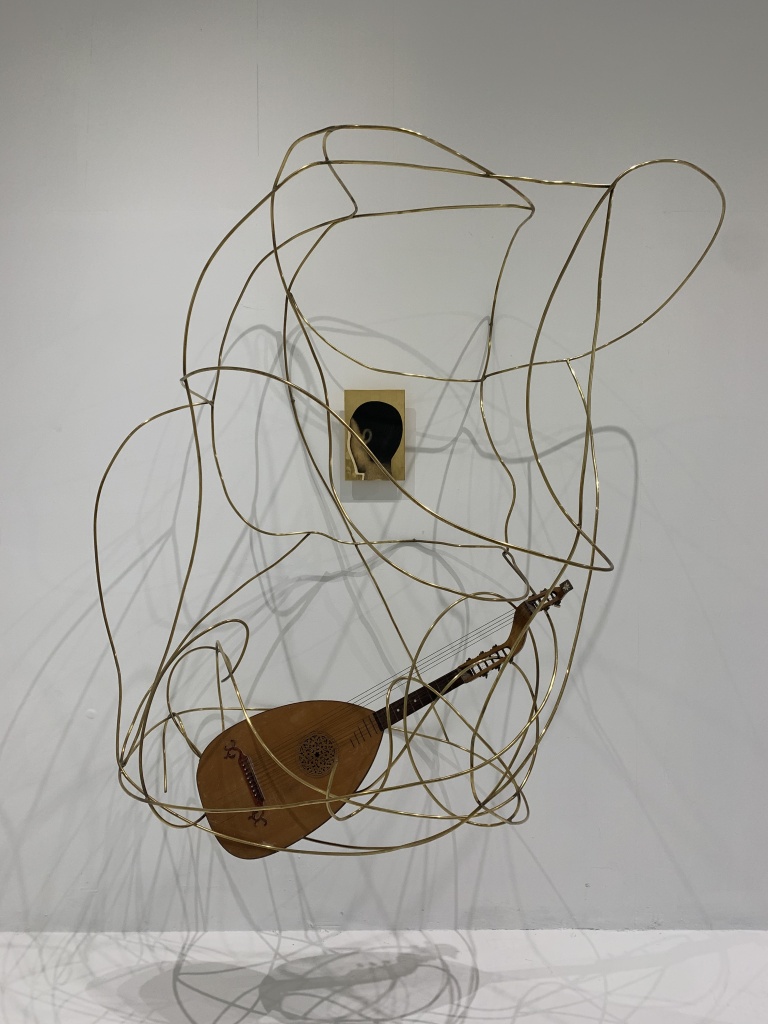
Mimmo Paladino’s LABYRINTHUS at Margulies Collection 2024 (Photo by Yana Judah // CC by 4.0)
I have a profound curiosity when someone speaks. When someone speaks, every word serves to contribute to their vision. The words weave a palpable notion of what is being expressed. And in a powerful fashion, they allow you to enter their world and give you an opportunity – an attempt – to see what they see, to feel how they feel. Some are better than others at articulating their intended message. And when you are in the presence of someone in full control – you can’t help but listen.
On February 2nd, 2023, our Art in Miami class visited the Margulies Collection at the Warehouse and had the distinct pleasure of meeting Mr. Margulies himself. And within ten seconds of hearing him speak, I knew our class was in for a real treat.
Mr. Margulies’ humorous and stellar story-telling abilities, in combination with his first-hand knowledge, brought to fruition an art history lesson of vibrancy. He explained how Marcel Duchamp, the forefather of conceptual art, shocked the world with his artwork, Fountain – a piece consisting of a urinal (Tate). Mr. Margulies elaborated on Duchamp’s challenge to traditional art ideas, such as repurposing objects, of who was considered to be an artist, and most significantly, the concept that the idea presented in the art was more important than the execution (Tate).
With this in mind, our class viewed The Margulies Collection at the Warehouse with pure fascination – conceptual art all around us. We saw ideas of destruction and rebirth, failure and perfectionism, identity and its revocation, knowledge and hidden truths, remembrance of youth and the realities of aging – all embedded in the various pieces.
One artwork that stood out to me above the rest portrayed a different idea, at least in my interpretation; it was one of articulation. Titled LABYRINTHUS and created by Mimmo Paladino, it is pictured above this blog post. When I first laid eyes on LABYRINTHUS, it genuinely made me stop and think for a while. As a matter of fact, after class, I made it a point to circle back and reevaluate it, just for a bit longer.
The lute, placed at the bottom of the piece, is encircled in a labyrinth of brass lines. Centered is an image of, assumably, a man’s head with his face partially turned away. To me, the multiple brass lines represent what happens when you play a musical instrument, such as a guitar, or when you improvise jazz lines when singing. Your mind, represented by the man’s head, is racing, attempting to form a coherent idea to present to the world. Many often experience this feeling when trying to express ourselves; perhaps we aren’t as articulate as we hope to be. It is funny since articulation has its own meaning in music, too, referring to the level of clarity you wish your notes to produce.
We may not all possess Mr. Margulies’ natural aptitude for communicating, but I think that’s why we hold a respective appreciation for specialties like art. Through art, ideas and concepts can be fully expressed and fully felt without spoken words. The art itself speaks in total governance.
Works Cited
Tate. “‘Fountain ‘, Marcel Duchamp, 1917, Replica 1964 | Tate.” Tate, http://www.tate.org.uk/art/artworks/duchamp-fountain-t07573.
Art Wynwood as Text
“The Pursuit of Happiness” by Yana Judah of FIU at Art Wynwood on February 16th, 2024
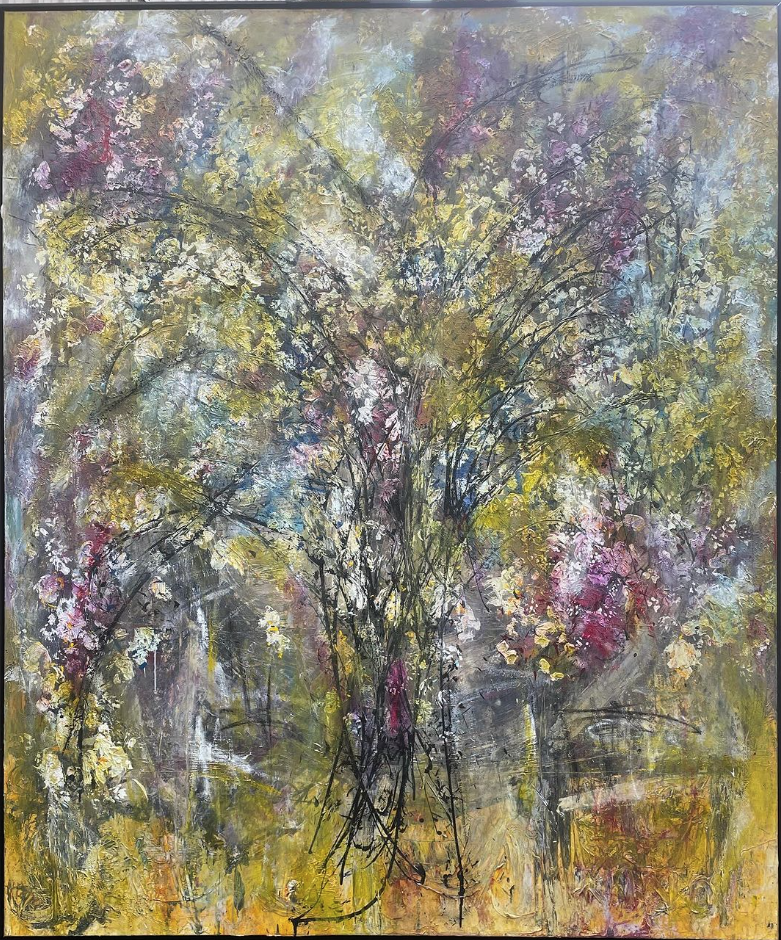
Anthony “Nino” Sarti’s The First Bouquet at Art Wynwood 2024 (Photo by Anthony “Nino” Sarti // (“Nino” Sarti.))
The harsh reality of the arts is that garnering financial success is notoriously difficult. To instantly emerge as one of the greats is rare; to be a household name while you are alive is a phenomenon; and earning enough capital to be comfortable, let alone stay afloat – well, it often amounts to an unfulfilled fantasy. Yet, and still, the dream to solely focus on your creatives hangs on.
To combat these circumstances, artists will often become actively engaged in their art worlds, both at home and abroad, to market their pieces and build rapport – Art Wynwood is a sure representation of this. And we, in Professor Bailly’s Art in Miami course, had the incredible opportunity to receive a complimentary entry to Art Wynwood.
Art Wynwood is a masterpiece – a formal collaboration featuring artists worldwide – a multi-cultural and multi-ethnic melting pot of art portrayed in various mediums. During this fair, we had our class lecture, and afterward, we were allowed to explore solo or in groups. Through this post-class exploration, my friend and I had the distinct pleasure of speaking to the gifted and very humorous (indeed, an emphasis on humor) Mr. Anthony “Nino” Sarti.
Mr. Sarti was an absolute joy to talk to, bringing a fresh and personal perspective on the current status of the art world. This was particularly beneficial for students such as ourselves who are unfamiliar with the circumstances that artists like himself must circumvent. The best way to understand the game is from someone embedded in it.
Hailing from the Bronx but currently studying at Callanwolde Fine Arts Center in Atlanta, Georgia, Mr. Sarti detailed the elaborate process he has to complete even one of his paintings: he meticulously stretches each canvas and crafts a custom frame for each individual piece. As he prefers to use acrylic paste and paint, which dries relatively quickly, it is often a race against the clock to finish (NINO SARTI). The results, however, are worth the labor; his paintings are mesmerizing as they exhibit movement and folds of texture. Moreover, Mr. Sarti chooses to retain the originality of each piece by not mass-producing his pieces. Instead, he opts to create a series of a piece. Each piece is distinctive and contains a story in its own right; when placed together, the series shows a timeline of artistic progression, a more extensive narrative encapsulated.
Mr. Sarti’s art is beautiful. It has been featured in art galleries across the United States and movies from Tyler Perry Studios and DC Comics (NINO SARTI). He is exceptional. Despite his successes, as he’s explained to my friend and me, there remains stressful variables. What should you price your art for? Is the price dependent on labor, solely on market value, or a combination of both? Which art curator should you commit to? Which artist will you do a joint exhibition with, and how will the expenses be divided? What types of advertising can you afford, and what is the timeline for a breakthrough? How do you earn the attention of prominent collectors and art dealers?
These are valid concerns and all valid grounds for any artist to consider halting or limiting their artistic endeavors, but as Mr. Sarti professes, “Pursue your passions…be original!” (NINO SARTI). I choose to believe this sentiment is what carries the dream forward. Pursuing your passions is a beautiful reminder that maybe success, while very much so, can be partially attributed to monetary or popularity gains, is foundationally one’s commitment to personal fulfillment – happiness. Maybe that alone, at least for some, is enough to sustain the dream.
As my friend and I wandered towards the next booths, our conversation with Mr. Sarti concluding with a joke and a farewell, we pondered the heaviness of what he shared and mutually applauded his active pursuit of passion: not everyone has the guts. May it be coincidence or happenstance, we found ourselves pausing at Ms. Elizabeth Clement’s gallery booth, an art dealer at Art Wynwood (“About — Liz Clement Fine Art and Contemporary”). Our inevitable conversation, although beginning with us questioning her on the intriguing pieces in her booth, somehow concluded with her warmly yet firmly encouraging us to pursue our dreams and passions. Perhaps that was confirmation.
I extend my gratitude to both Mr. Sarti and Ms. Clement. It can feel destabilizing when you consider that doing what you love may not pay the bills. However, it is more destabilizing to consider perpetual unhappiness.
Works Cited
Liz Clement Fine Art & Contemporary. “About — Liz Clement Fine Art & Contemporary,” n.d. https://www.lizclementfineart.com/about-1.
“Nino” Sarti., Anthony, [nino_sarti]. “The First Bouquet. 72 X 60 Acrylic Paste.” Instagram, 5 Jan. 2024.
Sarti, Anthony. NINO SARTI. 2024. Art Wynwood Fair, Pamphlet/Business Card.
Rubell/Emerson Dorsch as Text
“The Price of Honesty” by Yana Judah of FIU at Rubell/Emerson Dorsch on March 8th, 2024
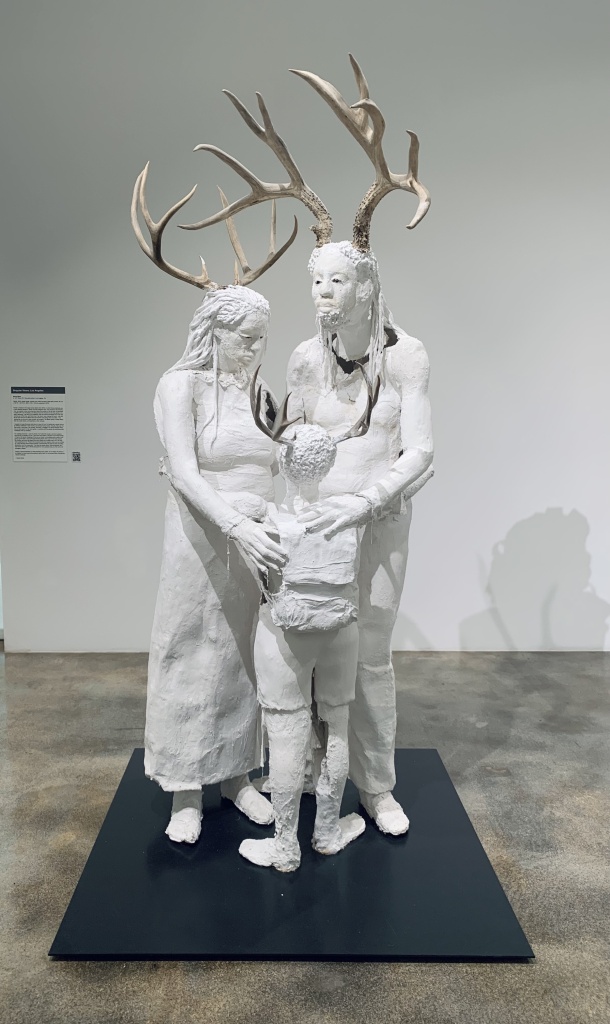
Karon Davis’ Family at Rubell Museum 2024 (Photo by Yana Judah // CC by 4.0)
Each Art in Miami blog post encourages us to capture our class ventures to a singular subject, experience, or overarching theme and reflect accordingly. Personally, however, this is a tad of a challenge when we visit multiple locations during the same class; the complexity of choice increases, as it may involve selecting one museum or galley over the other.
So, on March 8th, when we visited the Rubell Museum and the Emerson Dorsch Gallery, I truly contemplated which space to write about. Perhaps this was silly of me: why not do a coin toss or write about the more memorable one? The issue, which conceivably is not an issue at all, was that both places offered such striking authenticity. It is this choice to be authentic that connects the Rubell Museum and the Emerson Dorsch Gallery, and it is this same choice that invites me to speak on both.
Our first stop, the Rubell Museum, embraced us with open arms. Early access before the official public opening was a delight. And as our class made our way through the museum, we had the rare opportunity to see exhibits featuring Black artists such as Karon Davis, Sonia Boyce, Glenn Ligon, Kerry James Marshall, Mickalene Thomas, and Henry Taylor, and boy, did these artists not fail to represent.
As a Black American, witnessing their creative output was emotional; feeling relatability was painful but precious. Their works echo the commonalities of our shared hurt. Underrepresented, underappreciated, overlooked, misunderstood, and viewed as less: less prestigious, less qualified, less valuable—yet more dangerous. In culmination, producing an ache that is difficult to describe and even greater to experience first-hand.
So, when our class soaked in the symbolism of Karon Davis’ sculpture Family, tears fell. The sculpture portrays a Black family: a father, mother, and son embracing in a hug. The child, school-aged, carries a backpack. The parents are sending him off to school but are apprehensive. Manifested via their somber expressions: they know their child will not be safe; they know he may not return home (Davis). The family is entrenched in a rigged game, one in which they are meant to be hunted, meant to be slaughtered, and they know this. A stressful existence is not an existence.
Sprouted from each of their heads are antlers, child included. Ms. Davis cleverly justifies this placement as a talisman, allowing the family to “[transcend] the pain but also [provide] protection over [their] young son” (Davis). Maybe, just maybe, the family unit will survive. But, maybe.
So, perhaps the extent of this complicated anxiety will never be fully grasped with words alone, and possibly I am doing a lackluster job connecting Family to the Black experience. But when you see the sculpture, you feel it. And I felt it, and those in my class felt it. The mere idea of this unsettling reality haunted us.
The Rubell Museum made a deliberate choice to provide space for mentally confrontational artwork by permitting a ghastly truth to be revealed. If this sheer honesty were stifled, so would the potential reconciliations between Black Americans and their hope for a peaceful livelihood.
Although the Emerson Dorsch Gallery covers separate points of conversation from the Rubell Museum, it also relates to themes of openness. Upon entry, Emerson Dorsch Director Ibett Yanez del Castillo and Art Preparator Daniel Clapp made us feel at home. Moreover, we were greeted with candid conversations about managing a gallery: hauling delicate equipment, weighing the pros and cons of keeping an exhibit open, and probably the most taxing, the battle to break even.
Ms. Castillo and Mr. Clapp elaborated: when participating in an art fair, you must sell VIP night or opening day. If not, chances are you will not sell for the entirety of the fair. That first day may determine your gallery’s future and whether or not you can break even, let alone make a profit.
The conversation continued about the cynical nature of the art market, with artists receiving the short end of the stick. Often, if an artist is persuaded to sell their work, let’s say, initially for ten grand and their work is later again sold at an auction for millions, the artist does not receive a percentage. If contracts are drafted, they are often clouded with stipulations that can be overlooked—well, if you can afford the legal fees.
The art market is volatile and frequently unethical. However, Ms. Castillo and Mr. Clapp facilitated a conversation with their expert knowledge, information they did not have to share and could have easily manipulated.
In a world where honesty is a second-class citizen to convenience, it is incredibly hopeful to see those who reject norms for the sake of truth. This was my profound takeaway from the Rubell Museum and the Emerson Dorsch Gallery. Their sincerity shows a rich genuineness. Moreover, it speaks to a more consequential idea that we inherently understand honesty’s need but are often unwilling to commit to the process. But our reluctance comes with a price; see what happens when we are not. I urge you to mull over that nightmare.
Works Cited
Davis, Karon. “Family.” Description. Rubell Museum, 2019.
PAMM as Text
“Everforward (Neverback)” by Yana Judah of FIU at PAMM on March 29th, 2024

Gary Simmons’ Everforward… at PAMM 2024 (Photo by Yana Judah // CC by 4.0)
The eagerness to visit the Pérez Art Museum Miami (PAMM) was present from the get-go; its reputation is exceptional. Adding to the intrigue stemmed from Professor Bailly explaining that this tour, in particular, would be played out differently—a memorable experience in store for us, if you will: T. Elliot Mansa, an artist himself, would be guiding our tour. Mr. Mansa is accomplished, multidisciplinary, award-winning, and renowned for his ability to fuse “Southern vernacular aesthetics” into pieces that elicit the “radical imagination of viewers” (Luisa). Ultimately, his work encourages viewers to reflect on the racial-socio-political climate of their respective communities.
However, might I respectfully edit Mr. Mansa’s impressive resume to include the following: a student of history. History inspires his works and is depicted in them. And in hindsight, post-PAMM-tour, it is clear that Mr. Mansa’s aptitude for history helped our Art in Miami class absorb the heaviness of the exhibition we would see: Gary Simmons: Public Enemy.
A contemporary artist hailing from the Big Apple, Gary Simmons merges the complex lines between race and class using sports, music, and cinema (Pérez Art Museum Miami). The output is somber materializations, often invoking charged emotions. Public Enemy is an unmistakable representation of this.
Throughout Public Enemy, there was a common theme: the intentional removal of bodies. Not a single work showed a physical body—no, the body was implied by you and what you chose or, dare I say, what you were programmed to envision. This raises questions about who you are, but even more concerning, our society in the United States. Public Enemy included works like Lineup, showing the backdrop of a police lineup. There are no bodies, but there is a line of shoes with various sizes and brands. In another work, Disinformation Supremacy Board, a children’s classroom is shown, but there are no children present, and it appears unnaturally sterile. Both the chalkboard and chalk are white. To the left of this work hangs Ku Klux Klan uniforms; in horror, you realize they are intended for kids. You are forced to complete the image in both Lineup and Disinformation Supremacy Board. Who do you see, and why do you see what you see?
Mr. Simmons’ art tells a story, one that involves what you conjure in your mind and one that speaks to the evergoing battle of history: past versus present. The totality of this idea is summarized in Mr. Simmons’ Everforward… shown above this blog post. Two white boxing gloves are hung via a thick white thread. Both have gold engravings with a light pink background: the left glove with “Everforward” and the right glove with “Neverback.” Both gloves, slightly below their main engravings, have a “Made in the U.S.A” label.
We can recognize that boxing gloves, and per their purpose, indicate a fight and, in this case, a fight to move forward and avoid regression. It is poetic in many regards, as the Everforward glove is slightly behind the Neverback glove. It is as if Everforward is punching Neverback. It can also be interpreted as if both are working together to punch an unforeseen opponent, perhaps history attempting to make a repeat. The piece’s title contains an ellipsis at the end as if posing an almost questionable stance; perhaps it acts as a ghostly whisper: who will win the match?
The idea of Neverback is housed within Public Enemy. Lineup and Disinformation Supremacy Board are only two of several examples demonstrating the past and its alarming acceptance of inequality and cruelty. We know never to return to such a way of life because it occurred so horrifically in the first place; an absolute tragedy. We must go forward.
Interestingly enough, that same day at the PAMM, I believe our class experienced an “Everforward” moment. After Mr. Mansa’s tour, Professor Bailly brought our Art in Miami class to the third level of the PAMM, where we met Taylor Anderson, an artist in her own right. There, Ms. Anderson directed our class to create miniature zines, sharing crayons, markers, scissors, and magazines. While seemingly trivial, this activity symbolized progress; we are a multi-ethnic group of college students bonding through art while enjoying each other’s company. In retrospect, this is monumental: just fifty years ago, this would not have been normal, and one hundred years ago, this would have been a death sentence. As Mr. Mansa wisely expressed, “Everything normal someone fought for.” And that is the message of Everforward, a pursuit to forge ahead, with the past serving as a continuous cautionary guide.
Works Cited
Luisa. “T.Eliott_Mansa.” LnSGallery.com, 4 Aug. 2023, lnsgallery.com/t_eliott_mansa.
Pérez Art Museum Miami. “• Pérez Art Museum Miami.” Pérez Art Museum Miami, http://www.pamm.org/en/guide/gary-simmons-public-enemy/#MeetTheArtist.
Wolfsonian as Text
“Seven Seconds” by Yana Judah of FIU at Wolfsonian on April 5th, 2024
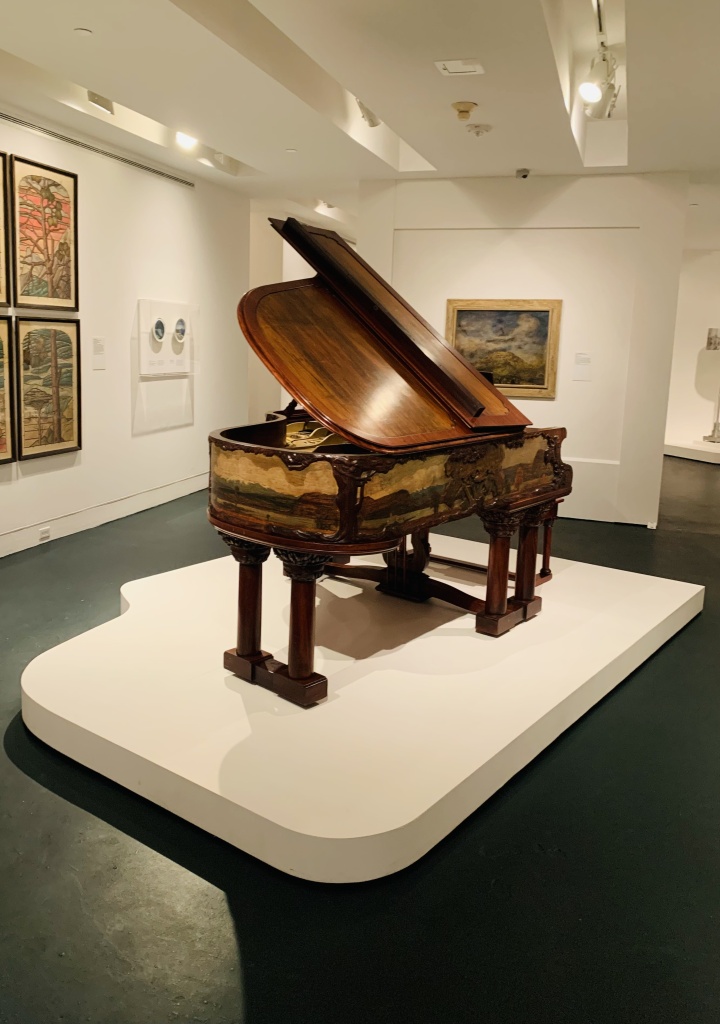
Joseph Henry Gest (painter), Clemont J. Barnhorn (sculptor), and Baldwin Piano Company (manufacturer) American Art Piano at Wolfsonian-FIU 2024 (Photo by Yana Judah // CC by 4.0)
Seven seconds—the time a person typically reserves to focus on an artwork. Seven seconds to be ferried into the artist’s world, be momentarily soaked with their ideas, and, in return, produce a self-derived explanation of the art shown. Possibly, this is enough time to grasp the surface-level perspective, but conceivably, the deeper meaning remains unclear. Thus, maybe all that inhibits this clarity is time.
Allow me to elaborate: On April 5th, the Wolfsonian–FIU received our Art in Miami class with quite an interactive tour. Led by Molly Channon, the Student and Academic Engagement Coordinator, we were introduced to the Wolfsonian’s founding and its progression to today, where it stands as a historical archive from 1850 to 1950, containing a museum and library (Florida International University – Digital Communications). Along the tour, we met with Luna Goldberg, the Assistant Director of Education, and Francis Luca, the Museum Chief Librarian, two generous individuals who assured us that the Wolfsonian serves as an accessible resource for FIU students and all those in the greater Miami area.
However, I must be candid; the section of the tour that genuinely caught me off guard was one in which we collectively engaged in a writing exercise. Ms. Channon brought our class to the upper levels of the Wolfsonian, which currently houses the exhibition The Big World: Alternative Landscapes in the Modern Era. There, we were equipped with a stool, clipboard, paper, and pencil and given tasks: divide into teams of five and choose an art piece. When the team agreed on a piece, we would sit—the chosen piece at the focal point.
Using our individual clipboards, we would pen a few sentences regarding the artwork: how it made us feel, why it made us feel, and what story we thought it conveyed—at this stage, all relevant thoughts would be worth writing. Upon finishing, we rotated clipboards, and the next team member wrote and continued the story—a living document, if you will. By the conclusion of this exercise, every student had a special composition of five writers telling one story.
The artwork my team selected is displayed above this blog post: American Art Piano, created in a collaborative effort by Joseph Henry Gest (painter), Clemont J. Barnhorn (sculptor), and Baldwin Piano Company (manufacturer). The mahogany piano’s base is strong, but still allows for the various subtleties of brown to seep through. The body’s mid-drift is “ornamentally carved and painted,” featuring “pastoral landscapes” of three-dimensional nature (Gest, Barnhorn, and Baldwin). The legs are sturdy, including intricate carvings, and entirely positioned on a thick white frame. Moreover, the piano’s lid is lifted, as if welcoming even visitors to play.
And as our team began to write, as we made the rounds exchanging our clipboards, it was clear that although we were peering at the same artwork, we would inevitably have five distinctive stories. But what a beautiful moment this was. We read each other’s responses, in turn encouraging our own: some choosing a philosophical route, others opting for a literal point of view. As a result, our clipboard stories were a joint effort containing a spectrum of perspectives. But this is what happens when seven seconds are prolonged to thirty minutes.
Shoutout to my team, as it truly was a memorable experience with them. Below is what we wrote on my clipboard. The writers are in the following order, each separated by a paragraph: Yana J. (myself), Isabella C., Elianyi P., Lazaro M., and Amy G.
The music of nature grants me serenity. I feel alive and hopeful —although I wonder: how long will it last?
Music compels emotions in ways that were not thought possible. Nature comes in sweet bliss…to be able to enjoy the sounds of life and bask in living through the sounds.
I wonder if the way the breeze rustles the leaves sounds the same as it did to my ancestors long ago.
Or the ocean waves still clash against sandy beaches, creating their own music. At times, calm, in others, slamming the land.
I wonder if my questions will ever get answered and if the answers can be heard if we make you sound. (Yana J., Isabella C., Elianyi P., Lazaro M., and Amy G.).
Work Cited
Florida International University – Digital Communications. “About.” The Wolfsonian | Florida International University | FIU, wolfsonian.org/about.
Gest, Joseph Henry (painter), Clemont J. Barnhorn (sculptor), and Baldwin Piano Company (manufacturer). “American Art Piano, 1904.” Description. Wolfsonian-FIU, Mitchell Wolfson Jr. Collection. The Big World: Alternative Landscapes in the Modern Era, 2024.
“Untitled Writing Activity.” By Yana J., Isabella C., Elianyi P., Lazaro M., and Amy G. Personal experience, April 5, 2024.
Art Final Reflection as Text
“Time, Space, and Matter” by Yana Judah of FIU on April 26th, 2024

Morel Doucet’s Untitled Art at Bakehouse Art Complex 2024 (Photo by JW Bailly // CC by 4.0)
As our Art in Miami course draws to an end, I am left with unexpressed emotions. However, as luck would have it, this final blog post serves as a reflection, a perfect canvas to clarify my disposition.
Without fail, every class offered new insights, especially touring various art institutions and having open conversations with working artists and curators. This combination has produced a golden environment for learning and encouraged me to use this reflection to highlight three lessons—three takeaways from this semester’s course.
Lesson 1: Space
I live in Miami. I was born in Miami. Yet, I never felt comfortably connected to Miami and, by extension, its art scene. To put it bluntly, I felt excluded. And while I dabble in the musical arts, I am not an art major, I am not a painter, and certainly not a drawer— further contributing to the barrier. Thankfully, the antidote was Professor Bailly’s Art in Miami course.
Often, we distance ourselves from spaces we feel we do not belong in. And while this discomfort can stem from apprehensions of an unwelcoming environment, it may also stem from a personal fear of feeling stupid. Is it not better to avoid the feelings of inadequacy—of incompetence? Well, no. And perhaps that is both a terrible hindrance to learning and a dangerous approach to life. Sometimes, if you just try, you discover that it was never as daunting as you imagined; you may even be pleasantly surprised with what you find. And that is exactly how I feel about Art in Miami.
Lesson 2: Time
Art has the potent power to encapsulate time in a medium. History, therefore, is naturally embedded within, an artifact for the future. Thus, as time progresses, the art’s integrity must stay intact not only physically but historically.
While FIU students are increasingly encouraged to independently analyze and interpret the world around us, we must uphold the need for history as well. To put it simply, the need to hold on to historical facts must grow simultaneously with increased encouragement of interpretation.
While inherently, interpretation teaches critical thinking; we must stay cognizant of how much interpretation to let in when, for example, analyzing an art piece and neglecting its true historical context. Moreover, when interpreting art, we must heed the warning of confirmation bias. Art matters, and the context of art matters as well. Roughly paraphrased by Professor Bailly himself, “Facts will prevent people from interpreting the wrong thing.”
Lesson 3: Matter
People matter. Experiences matter. Memories matter.
I had previously taken a course with Professor Bailly, Miami in Miami, so there was no question that Art in Miami would also be a high-quality, enriching course with unforgettable experiences. Still, I cannot even begin to articulate how overflowed with gratitude I am. To have been a part of this microcosm of FIU’s Honors College was such a clear reminder that we cannot take anything for granted.
I extend my sincerest thanks to FIU’s Honor College for offering Art in Miami and to Professor Bailly for his exceptional teaching, infectious enthusiasm, and impeccable comedic timing.
Reflecting post-Art in Miami, my heart swells with incredible joy—and sadness. The type of sadness that ensues when you realize something great has finally come to an end.